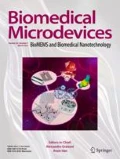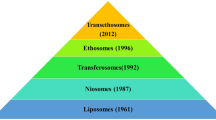Abstract
Needle-free liquid jet injectors are devices developed for the delivery of pharmaceutical solutions through the skin. In this paper, we investigated for the first time the ability of these devices to deliver intact lipid vesicles. Diclofenac sodium loaded phospholipid vesicles of two types, namely liposomes and transfersomes, were prepared and fully characterized. The lipid vesicles were delivered through a skin specimen using a jet injector and the collected samples were analyzed to assess vesicle structural integrity, drug retention and release kinetics after the injection. In this regard, data concerning size, size distribution, surface charge of vesicles and bilayer integrity and thickness, before and after the injections, were measured by dynamic light scattering experiments, cryo-electron microscopy, and X-ray scattering techniques. Finally, the effect of vesicle fast jet injection through the skin on drug release kinetics was checked by in vitro experiments. The retention of the morphological, physico-chemical, and technological features after injection, proved the integrity of vesicles after skin crossing as a high-speed liquid jet. The delivery of undamaged vesicular carriers beneath the skin is of utmost importance to create a controlled release drug depot in the hypoderm, which may be beneficial for several localized therapies. Overall results reported in this paper may broaden the range of application of liquid jet injectors to lipid vesicle based formulations thus combining beneficial performance of painless devices with those of liposomal drug delivery systems.





Similar content being viewed by others
References
T. M. Allen, P. R. Cullis, Adv. Drug Deliv. Rev. 65, 36–48 (2013)
A. Arora, M. R. Prausnitzc, S. Mitragotri, Int. J. Pharm. 364, 227–236 (2008)
J. Baxter, S. Mitragotri, Expert Rev. Med. Devices 3, 565–574 (2006)
C. Caddeo, M. Manconi, A. M. Fadda, F. Lai, S. Lampis, O. Diez Sales, C. Sinico, Colloids Surf. B: Biointerfaces 11, 327–332 (2013)
G. Cevc, G. Blume, Biochim. Biophys. Acta 1663, 61–73 (2004)
F. Cilurzo, P. Minghetti, C. Sinico, AAPS PharmSciTech 8, art. 94 (2007)
D. Cosco, C. Celia, F. Cilurzo, E. Trapasso, D. Paolino, Expert Opin. Drug Deliv. 5, 737–755 (2008)
M. M. A. Elsayed, O. Y. Abdallah, V. F. Naggar, N. M. Khalafallah, Int. J. Pharm. 332, 1–16 (2007)
C. F. Goh, M. E. Lane, Int. J. Pharm. 473, 607–616 (2014)
G. Gregoriadis, Liposome technology, 2nd ed (CRC press, London, 1993)
M. Harris, R. Joy, G. Larsen, M. Valyi, E. Walker, L.W. Frick, R.M. Palmatier, S.A. Wring, J.S. Montaner AIDS 20, 719–723 (2006)
D. Leng, H. Chen, G. Li, M. Guo, Z. Zhu, L. Xu, Y. Wang, Int. J. Pharm. 472(1-2), 380–385 (2014)
Y. Michinaka, S. Mitragotri, J. Control. Release 153, 249–254 (2011)
S. Mitragotri, Nat. Rev. Drug Discov. 5, 543–548 (2006)
S. Murgia, A. M. Falchi, M. Carboni, S. Lampis, C. Sinico, M. L. Manca, J. Schmidt, Y. Talmon, M. Monduzzi, Adv. Healthcare Mater. 2, 692–701 (2013)
B. Ozbakir, B. J. Crielaard, J. M. Metselaar, G. Storm, T. Lammers, J. Control. Release 190, 624–636 (2014)
G. Pabst, M. Rappolt, H. Amenitsch, P. Laggner, Phys. Rev. E 62, 4000–4009 (2000)
J. Pan, S. Tristram-Nagle, N. Kučerka, J. F. Nagle, Biophys. J. 94, 117–124 (2008)
J. Schramm-Baxter, S. Mitragotri, J. Control. Release 97, 527–535 (2004)
C. Sinico, A. M. Fadda, Expert Opin. Drug Deliv. 6, 813–825 (2009)
C. Sinico, D. Valenti, M. Manconi, F. Lai, A. M. Fadda, J. Drug Deliv, Sci. Technol. 16, 115–120 (2006)
Y. Talmon, J. Mol. Liq. 210, 2–8 (2015)
Acknowledgments
Yeshayahu Talmon and Judith Schmidt are kindly thanked for the cryo-TEM images. The cryo-TEM work was performed at the Technion Laboratory for Electron Microscopy of Soft matter, supported by the Technion Russell Berrie Nanotechnology Institute (RBNI).
Author information
Authors and Affiliations
Corresponding author
Ethics declarations
Grants
This work was partially supported by a grant from MIUR, Italy (PRIN 2010–2011, Prot. 2010H834LS 004).
Rights and permissions
About this article
Cite this article
Schlich, M., Lai, F., Murgia, S. et al. Needle-free jet injection of intact phospholipid vesicles across the skin: a feasibility study. Biomed Microdevices 18, 67 (2016). https://doi.org/10.1007/s10544-016-0098-3
Published:
DOI: https://doi.org/10.1007/s10544-016-0098-3




